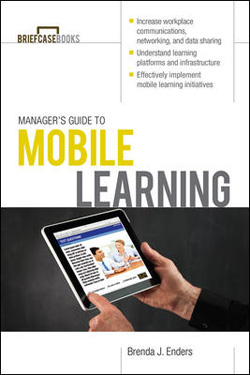It should come as no surprise that mobile device usage has penetrated nearly every corner of the globe. From hip coffee shops in the US to Internet cafés in east Africa and most everywhere in between, our mobile devices are almost always at arm’s reach. So how can we, as learning managers, harness the potential of this ubiquitous technology? In her book Manager’s Guide to Mobile Learning, Brenda Enders charts a path for implementing and managing mobile learning, or mLearning, projects with helpful advice, examples, and tips based on her own experiences.
What’s in the book?

The first four chapters of Manager’s Guide to Mobile Learning provide an overview of mobile learning, setting the stage for the step-by-step insights in subsequent chapters. These chapters introduce the state of the industry; outline business drivers, benefits, and challenges of mLearning; underscore the power of mLearning in reaching learners anytime, anywhere; and detail the types of mLearning experiences that organizations should consider.
The strength of this section lies in the details provided around myths, benefits, and challenges associated with mLearning. Thankfully, Enders is quick to point out that “mobile learning isn’t really about the technology or the device, and it shouldn’t be a primary mechanism to deliver your eLearning courses.” Rather, mobile learning initiatives should be viewed as a way to expand learning opportunities, giving learners access to location- and context-specific content anytime, anywhere, and at the moment of need (as explained by Bob Mosher and Conrad Gottfredson, “Are You Meeting All Five Moments of Learning Need?,” in Learning Solutions Magazine).
The middle section of the book, Chapters 5 through 8, walks readers through the steps required to craft an mLearning vision statement, identify various stakeholder requirements, analyze technical considerations, and determine whether in-house development or an outside vendor makes the most sense for an mLearning project. For experienced managers, some of this section may seem a bit rudimentary, but tools such as a sample mobile readiness survey and lists of questions to ask at various stages throughout a project’s lifecycle will be helpful to most. Perhaps the most beneficial discussion in this section lies in the pros/cons and security, platform, and tracking considerations related to BYOD—bring your own device. Indeed, many companies are adopting BYOD policies, and this chapter will certainly help educate managers as they prepare for conversations with various project stakeholders, most especially IT departments.
The final three chapters of the book focus generally on project management, with ideas and insights for engaging stakeholders, working through the development process, and piloting and launching an mLearning project. As before, experienced managers may find eight pages dedicated to the ADDIE model too fundamental and not specific to mobile learning. Although Enders does discuss benefits of an agile approach over ADDIE specific to mobile learning, she makes no reference to Michael Allen’s SAM, which seems to be an obvious omission, as the successive approximation model is an iterative, agile approach to instructional design. That said, this section offers helpful pearls of wisdom that can be applied to piloting and implementing most any learning initiative—whether mLearning, eLearning, or a blend of both.
The bottom line
As part of the Briefcase Books series, Manager’s Guide to Mobile Learning is designed to provide practical information in an easy-to-read format. Numerous sidebars and call-out boxes provide additional details relevant to the topic at hand. These nuggets, scattered throughout the book, provide the perfect dose of real-world application. Along with the “Manager’s Checklists” at the conclusion of each chapter, readers are sure to walk away with ideas and inspiration that can be put to use immediately.
Though rare, a few lists and references will quickly outdate the book as new companies, tools, and methodologies enter the market. Even so, Enders’ Manager’s Guide to Mobile Learning is full of questions, planning considerations, and guidance that will improve the odds that your next mLearning project is a success and generates positive results for your organization.
Bibliographic information
Enders, Brenda. Manager’s Guide to Mobile Learning. Madison, WI: McGraw-Hill, 2013.

